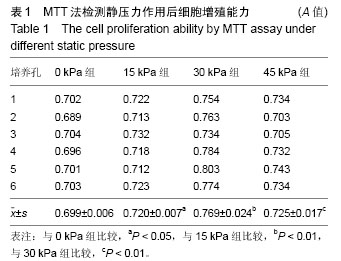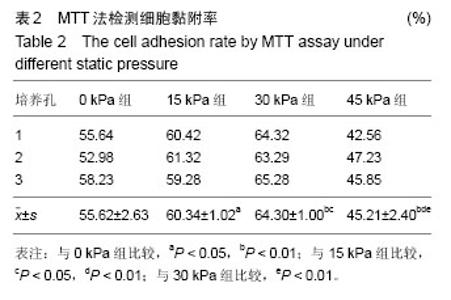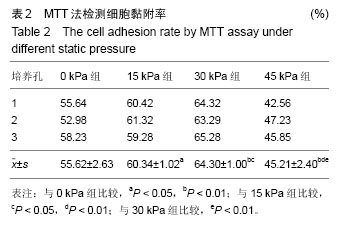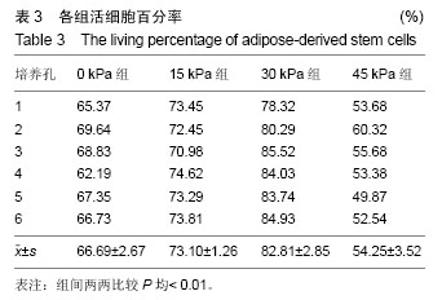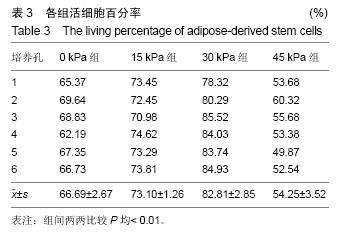| [1] Gimble JM, Katz AJ, Bunnell BA. Adipose-derived stem cells for regenerative medicine. Circ Res. 2007; 100(9):1249-1260.
[2] Dai R, Wang Z, Samanipour R, et al. Adipose-Derived Stem Cells for Tissue Engineering and Regenerative Medicine Applications. Stem Cells Int. 2016;2016: 6737345.
[3] Chen L, Peng EJ, Zeng XY, et al. Comparison of the proliferation, viability, and differentiation capacity of adipose-derived stem cells from different anatomic sites in rabbits. Cells Tissues Organs. 2012;196(1):13-22.
[4] Liao GY, Chen L, Zeng XY, et al. Electrospun poly(L-lactide)/poly(ε- caprolactone) blend fibers and their cellular response to adipose-derived stem cells. Journal of Applied Polymer Science. 2011; 120: 2154-2165.
[5] Chen L, Bai Y, Liao G, et al. Electrospun poly(L-lactide)/poly(ε-caprolactone) blend nanofibrous scaffold: characterization and biocompatibility with human adipose-derived stem cells. PLoS One. 2013; 8(8):e71265.
[6] 陈亮,彭鄂军,吴柏霖,等. 静电纺丝聚乳酸/聚己内酯共混纤维支架与兔脂肪源干细胞的体外生物相容性研究[J].华中科技大学学报:医学版, 2011, 40(5): 513-516.
[7] 白轶,陈亮,彭鄂军,等.静电纺丝聚乳酸/聚己内酯共混纳米纤维的体外细胞相容性[J]. 中华实验外科杂志, 2012, 29(11): 2240-2242.
[8] Li G, Fu N, Yang X, et al. Mechanical compressive force inhibits adipogenesis of adipose stem cells. Cell Prolif. 2013;46(5):586-594.
[9] Trumbull A, Subramanian G, Yildirim-Ayan E. Mechanoresponsive musculoskeletal tissue differentiation of adipose-derived stem cells. Biomed Eng Online. 2016;15:43.
[10] Pauly HM, Kelly DJ, Popat KC, et al. Mechanical properties and cellular response of novel electrospun nanofibers for ligament tissue engineering: Effects of orientation and geometry. J Mech Behav Biomed Mater. 2016;61:258-270.
[11] Hosseini MS, Tafazzoli-Shadpour M, Haghighipour N, et al. The synergistic effects of shear stress and cyclic hydrostatic pressure modulate chondrogenic induction of human mesenchymal stem cells. Int J Artif Organs. 2015;38(10):557-564.
[12] Huang CW, Huang CC, Chen YL, et al. Shear Stress Induces Differentiation of Endothelial Lineage Cells to Protect Neonatal Brain from Hypoxic-Ischemic Injury through NRP1 and VEGFR2 Signaling. Biomed Res Int. 2015;2015:862485.
[13] Park H, Lee JW, Park KE, et al. Stress response of fibroblasts adherent to the surface of plasma-treated poly(lactic-co-glycolic acid) nanofiber matrices. Colloids Surf B Biointerfaces. 2010;77(1):90-95.
[14] 金作林,罗颂椒,林珠,等.体外培养观察人牙囊细胞中细胞程序性死亡及其在不同流体静压力下的变化[J].华西口腔医学杂志, 2006, 24(5):466-468.
[15] Stachewicz U, Peker I, Tu W, et al. Stress delocalization in crack tolerant electrospun nanofiber networks. ACS Appl Mater Interfaces. 2011;3(6):1991-1996.
[16] 史亮亮,张柏江,林俊安,等.持续性压力通过影响ERK1/2和GIT1的结合促进大鼠成骨细胞的迁移[J].南京医科大学学报:自然科学版, 2009, 29(7):934-938.
[17] 冯剑颖,谷志远,林新平,等.持续静压力对大鼠成纤维样滑膜细胞PRG4表达的影响[J]. 口腔颌面修复学杂志, 2010,11(2):75-78.
[18] 李松,郭维华,徐芸.不同静压力对新生SD大鼠髁突软骨细胞增殖与凋亡的影响[J].实用口腔医学杂志, 2007, 23(6): 822-825.
[19] Chawla V, Simionescu A, Langan EM 3rd, et al. Influence of clinically relevant mechanical forces on vascular smooth muscle cells under chronic high glucose: An In Vitro Dynamic Disease Model. Ann Vasc Surg. 2016 Apr 25. [Epub ahead of print]
[20] Andersen JI, Juhl M, Nielsen T, et al. Uniaxial cyclic strain enhances adipose-derived stem cell fusion with skeletal myocytes. Biochem Biophys Res Commun. 2014;450(2):1083-1088.
[21] Yuan Y, Gao J, Ogawa R. Mechanobiology and Mechanotherapy of Adipose Tissue-Effect of Mechanical Force on Fat Tissue Engineering. Plast Reconstr Surg Glob Open. 2016;3(12):e578.
[22] Kanthilal M, Darling EM. Characterization of mechanical and regenerative properties of human, adipose stromal cells. Cell Mol Bioeng. 2014;7(4):585-597.
[23] Rim NG, Shin CS, Shin H. Current approaches to electrospun nanofibers for tissue engineering. Biomed Mater. 2013;8(1):014102.
[24] Arahira T, Todo M. Variation of mechanical behavior of β-TCP/collagen two phase composite scaffold with mesenchymal stem cell in vitro. J Mech Behav Biomed Mater. 2016;61:464-474.
[25] Nowotny J, Aibibu D, Farack J, et al. Novel fiber-based pure chitosan scaffold for tendon augmentation: biomechanical and cell biological evaluation. J Biomater Sci Polym Ed. 2016 Apr 23 [Epub ahead of print]
[26] Fuller KP, Gaspar D, Delgado LM, et al. Influence of porosity and pore shape on structural, mechanical and biological properties of poly ?-caprolactone electro-spun fibrous scaffolds. Nanomedicine (Lond). 2016;11(9):1031-1040. |

